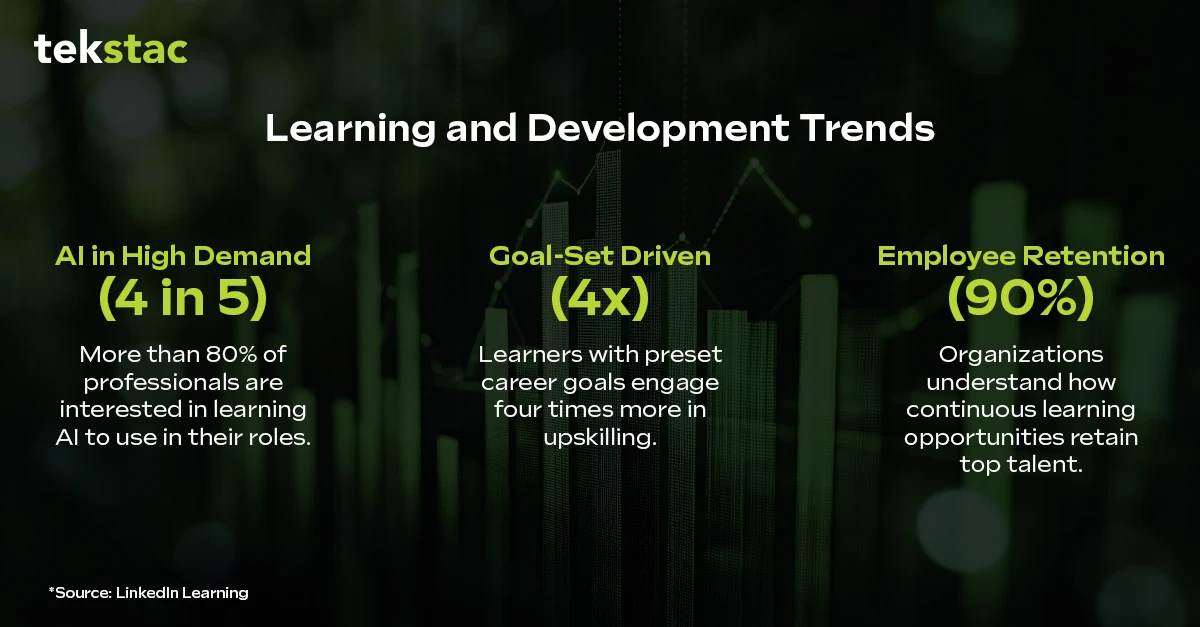7 Learning and Development Trends Shaping Enterprise Strategy in 2026
September 1, 2025

Discover the 7 learning and development trends for upskilling in 2026, from AI-driven to VR training and continuous learning. Try to stay ahead in that bell curve and succeed in your career!
What Are the Top Learning and Development Trends for 2026?
With growing dependencies on Gen AI, learning & development departments will continuously evolve in 2026. In order to stay relevant in the growing market, it’s imperative to follow the latest trends and be a part of a futuristic workplace.
So, what are the top Learning and Development Trends for 2026?
The leading L&D trends include AI-driven upskilling, hyper-personalized learning paths, microlearning, and data-driven learning strategies.
Read on to deep dive into what’s new in L&D and where it’s all headed.
US Learning & Development Trends: Insights from WEF Report
According to the Future of Jobs Report 2025 by the World Economic Forum, the findings related to the USA show that organizations are taking significant steps to prepare their workforce for the future.
Key observations include:
- 39% of workers (Global: 41%) do not need training by 2030.
- 29% of workers (Global: 29%) would be upskilled in their current role.
- 21% of workers (Global: 19%) would be upskilled and redeployed.
- 11% of workers (Global: 11%) say they would be unlikely to upskill.
- 94% of respondents identified AI and related technologies (e.g., big data, virtual reality, augmented reality) as key drivers of business transformation.
Corporate L&D Trends Shaping Enterprises in 2026
Whether you’re looking to reskill, upskill, or future-proof your workforce, staying aligned with the latest L&D innovations is essential.
Let’s explore the top 7 corporate learning and development trends set to create growth waves in 2026.
- AI-Driven Skill Development for Future-Ready Employees
- Hyper-Personalized Upskilling Method
- Microlearning
- Immersive Learning
- Data-Driven Learning
- Gamification
- Social Learning Platforms

1. AI-Driven Skill Development for Future-Ready Employees
AI or Artificial Intelligence is crucial for skill development. It helps companies to identify gaps and forecast futuristic upskilling requirements.
What we now need in 2026 is Responsible AI adoption. Companies need to design Human+AI approach that enables people to thrive in partnership with AI.
Following this allows IT aspirants to align their knowledge with the current demand for skills and to stay ahead of the bell curve such as artificial intelligence, blockchain, and cloud computing.
2. Hyper-Personalized Upskilling Method
The corporate L&D Program has shifted towards personalized learning where content is customized based on each learner’s skill, responsibility, and goal in career.
In the coming years, companies will focus on specific skills for each person rather than on predefined roles. It leads to greater agility and fills the skill gaps more easily.
3. Microlearning
As professionals are becoming busier, on-demand upskilling has concise. Microlearning is going to dominate L&D strategies in the coming years. It involves bite-sized content to be learned in minutes, which makes it perfect for IT teams who manage tight schedules.
They can learn quickly and apply at any time level of experience. They are perfect for mobile learning and reinforce knowledge through repetition. Tekstac supports microlearning, allowing learners to get access to training modules anywhere, anytime.
4. Immersive Learning
2026, like this year, will equally advocate continuous learning culture with the power of immersive learning technologies. AR or Augmented Reality and VR or Virtual Reality will reign supreme in 2026 also.
With this, IT professionals can engage in the simulated environment to practice troubleshooting systems and coding and handling any complex projects without the risk of the real world.
5. Data-Driven Learning
With the great pressure of the ROI of training programs, the Learning and Development trends in 2026 have been data-driven. Data analytics is the core of any training these days to optimize and customize training programs based on performance metrics, skill gaps, and learning experiences.
For instance, at Tekstac, trainers collect and analyze information from different sources like learning management systems, performance assessments, and feedback surveys, to learn the areas of improvement. Later the insight is used to customize training content, and progress tracking, and to adjust strategies for real-time upskilling.
6. Gamification
The future of corporate learning mostly relies on engagement metrics. The more engaging the training, the better results. Gamification is more than a buzzword. It’s a powerful tool for engaging employees, driving motivation, and fostering collaboration within teams. Gamified learning in 2026 will include AI, VR and AR in the learning environments, setting new benchmarks in immersive learning experiences.
Hybrid and remote working are the future, and it becomes necessary to create engaging L&D programs for remote teams through gamified eLearning. And who doesn’t enjoy a dynamic, game-based learning experience with a bit of healthy competition?
7. Social Learning Platforms
Social learning methodologies are transforming employee training and development in miraculous ways. Platforms like LinkedIn and internal social platforms within organizations are taking precedence for knowledge sharing and group discussions.
Not only that, incorporating interactive forums within LMS tools helps employees engage in real-time and share insights.
Summary of Learning and Development trends
In a nutshell, the main Learning & Development trends in 2026 will continue to be around AI, employee engagement and continuous learning.
Collaborate with solutions like Tekstac to harness the power of cutting-edge learning platforms and drive success. Because the future of work is in evolving and educating peers for company’s collective growth.
Learn better to work better!
FAQs on L&D Trends
1. Why is continuous learning important in 2026?
Continuous learning helps IT professionals to upskill with the latest technologies and perform well. Upskilling makes them more productive and gives job satisfaction in the long term.
2. What is involved in Learning and Development programs?
AI-driven upskilling, hyper-personalized learning paths, microlearning, and data-driven learning strategies.
3. How do companies implement effective L&D programs?
Companies can hire an L&D platform like Tekstac for workforce upskilling needs, where it provides skill-based continuous training to the talents by equipping them with the right tools and knowledge.
4. Why is AI important in corporate learning and development?
AI helps organizations identify skill gaps, personalize learning paths, and predict future upskilling needs. It enhances learning efficiency and supports real-time progress tracking.





